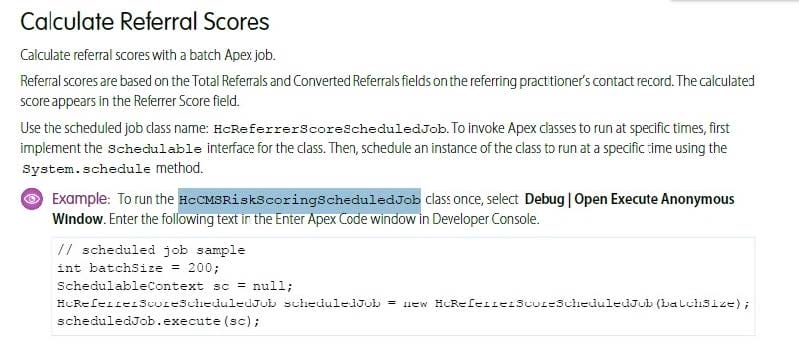Exam Details
Exam Code
:HEALTH-CLOUD-ACCREDITED-PROFESSIONALExam Name
:Salesforce Health Cloud Accredited ProfessionalCertification
:Salesforce CertificationsVendor
:SalesforceTotal Questions
:228 Q&AsLast Updated
:Mar 28, 2025
Salesforce Salesforce Certifications HEALTH-CLOUD-ACCREDITED-PROFESSIONAL Questions & Answers
-
Question 201:
A provider wants its care coordinators to track a series of problems, goals, and interventions (PGIs) related to a patient's care in a repeatable, efficient way. Which approach should a consultant recommend?
A. Configure an action plan template with tasks for each PGI.
B. Coach the care coordinators to quickly create tasks using a checklist.
C. Create care program templates and assign them to patients.
D. Define a PGI Library and care plan templates using the library.
-
Question 202:
A consultant needs to implement Health Cloud and is in the discovery stage of the project.
Which three approaches should the consultant consider to collect information to understand where Health Cloud fits within the application architecture? (Choose Three)
A. Identify personas involved and their existing pain points.
B. Start writing Apex code to customize Health Cloud
C. Build an architecture diagram depicting HealthCloud integrations
D. Create business process diagrams to understand information flow
E. Identify key stakeholders and how they measure success
-
Question 203:
A provider's office wants to verify a patient's insurance plan information and coverage when they call into the call center to book an appointment.
Which capability should a consultantleverage to address this requirement?
A. Utilization Management
B. Intelligent Appointment Management
C. identity Verification
D. Benefits Eligibility and Verification
-
Question 204:
An administrator wants to add additional fields to their Provider Searchcapabilities. Which two objects can they map fields from? (Choose Two)
A. Healthcare Practitioner Facility
B. Care Provider Searchable Field
C. Person Account
D. Account
E. Healthcare Provider
-
Question 205:
A pharma company wants the ability to:
Upload a patient's insurance card, including automatic Member Plan record creation Run a benefits verification check Schedule on behalf of the patient with a provider
Which set of Health Cloud capabilities should enable the company to build this business process?
A. Intelligent Document Automation, Intelligent Appointment Management, Intelligent Document Reader, Benefits Verification
B. Virtual Care, Intelligent Appointment Management, Intelligent Document Automation, Intelligent DocumentReader
C. Intelligent Appointment Management, Benefits Verification, Intelligent Document Automation, eFax Integration
D. Utilization Management, Care Management, Intelligent Document Automation, Intelligent Appointment Management
-
Question 206:
Bloomington Caregivers wants to share details about a patient's medical condition with Bedrock Hospitals through an integration. What should a consultant recommend as the appropriate method for Bedrock to access the information leveraging Health Cloud functionality?
A. Expose the MedicalCondition object through an Apex class.
B. Integrate using the FHIR Clinical API
C. Use the FHIR Patient API through DataRaptor
D. Leverage the MedicalCondition Integration Procedure.
-
Question 207:
What is the difference betweenCare Program and Care Plans in Health Cloud?
A. Care Programs track a patient's overall health journey, while Care Plans are more focused on specific care needs.
B. Care Plans can be exposed in a community while Care Programs cannot.
C. Care Plans are only used by Providers and Payers while Care Programs are only used by Life Sciences companies.
D. Care Programs are just a different type of Care Plan which capture more details such as financial information.
E. Care Programs are an extension on Care Plans.
-
Question 208:
Bloomington Caregivers would like to send patient clinical data to an external payer, how should a consultant advise Bloomington Caregivers to make this information available to the payer using the most cost-effective method in out-of-thebox Health Cloud?
A. Build a custom remote call-in API into Salesforce.
B. Leverage the FHIR R4 Patient API
C. Use MuleSoft Accelerator with H 7 APL D. use a third-party tool from AppExChange.
-
Question 209:
Bloomington Caregivershas decided to enable Integrated Care Management so that its end users can leverage Health Cloud Assessments. Administrators must now configure their org to be able to use Assessments.
Which three steps should the administrator take as part of the org setup to enable Assessments? (Choose Three)
A. Enable Discovery Framework in Setup.
B. Add the Assessment component to the Patient page.
C. Download and Install OmniStudio.
D. Update sharing settings in Setup.
E. Enable users to view and complete Assessments.
-
Question 210:
A provider system wants to leverage Health Cloud to enable its care providers to conduct video visits socioeconomic factors that impact their care.
Which capability should a consultant recommend for this use case?
A. IntegratedCare Management
B. Intelligent Appointment Management
C. Telehealth
D. Virtual Care
Related Exams:
201-COMMERCIAL-BANKING-FUNCTIONAL
Salesforce enCino 201 Commercial Banking FunctionalADM-201
Administration Essentials for New AdminsADM-211
Administration Essentials for Experienced AdminADVANCED-ADMINISTRATOR
Salesforce Certified Advanced AdministratorADVANCED-CROSS-CHANNEL
Salesforce Advanced Cross Channel Accredited ProfessionalADX-201
Administrative Essentials for New Admins in Lightning ExperienceADX-271
Salesforce Certified Community Cloud ConsultantAGENTFORCE-SPECIALIST
Salesforce Certified Agentforce SpecialistANC-301
Working with Data and Dashboards in Einstein AnalyticsB2B-COMMERCE-ADMINISTRATOR
Salesforce Accredited B2B Commerce Administrator
Tips on How to Prepare for the Exams
Nowadays, the certification exams become more and more important and required by more and more enterprises when applying for a job. But how to prepare for the exam effectively? How to prepare for the exam in a short time with less efforts? How to get a ideal result and how to find the most reliable resources? Here on Vcedump.com, you will find all the answers. Vcedump.com provide not only Salesforce exam questions, answers and explanations but also complete assistance on your exam preparation and certification application. If you are confused on your HEALTH-CLOUD-ACCREDITED-PROFESSIONAL exam preparations and Salesforce certification application, do not hesitate to visit our Vcedump.com to find your solutions here.
